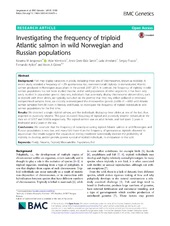Investigating the frequency of triploid Atlantic salmon in wild Norwegian and Russian populations
Jørgensen, Katarina Mariann; Wennevik, Vidar; Sørvik, Anne Grete Eide; Unneland, Laila; Prusov, Sergey; Ayllon, Fernando; Glover, Kevin
Peer reviewed, Journal article
Published version

Åpne
Permanent lenke
https://hdl.handle.net/1956/19243Utgivelsesdato
2018-10-03Metadata
Vis full innførselSamlinger
Originalversjon
https://doi.org/10.1186/s12863-018-0676-xSammendrag
Background Fish may display variations in ploidy, including three sets of chromosomes, known as triploidy. A recent study revealed a frequency of ~ 2% spontaneous (i.e., non-intentional) triploidy in domesticated Atlantic salmon produced in Norwegian aquaculture in the period 2007–2014. In contrast, the frequency of triploidy in wild salmon populations has not been studied thus far, and in wild populations of other organisms, it has been very rarely studied. In population genetic data sets, individuals that potentially display chromosome abnormalities, such as triploids with three alleles, are typically excluded on the premise that they may reflect polluted or otherwise compromised samples. Here, we critically re-investigated the microsatellite genetic profile of ~ 6000 wild Atlantic salmon sampled from 80 rivers in Norway and Russia, to investigate the frequency of triploid individuals in wild salmon populations for the first time. Results We detected a single triploid salmon, and five individuals displaying three alleles at one of the loci, thus regarded as putatively trisomic. This gave an overall frequency of triploid and putatively trisomic individuals in the data set of 0.017 and 0.083% respectively. The triploid salmon was an adult female, and had spent 2 years in freshwater and 2 years in the sea. Conclusions We conclude that the frequency of naturally-occurring triploid Atlantic salmon in wild Norwegian and Russian populations is very low, and many-fold lower than the frequency of spontaneous triploids observed in aquaculture. Our results suggest that aquaculture rearing conditions substantially increase the probability of triploidy to develop, and/or permits greater survival of triploid individuals, in comparison to the wild.
